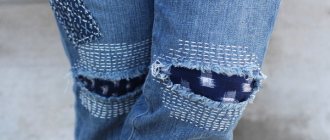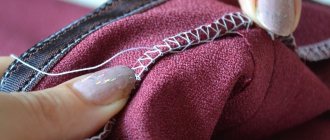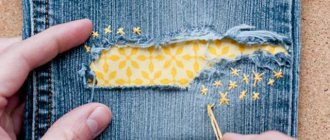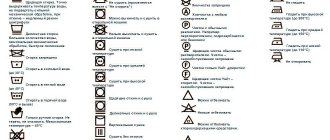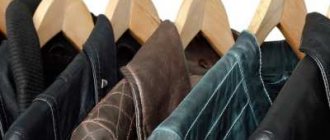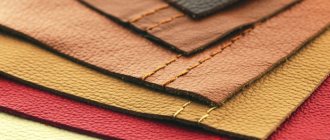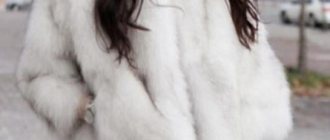Plastering on a sewing machine
You can repair jeans by using the plastering method. This technology is most often used in the repair of men's wardrobe items. True, it can also be used if a woman tears her pants. The main thing is that the sewing machine has a function that involves laying seams not only in the forward direction, but also in the reverse direction.
To patch jeans, you should choose threads of the same color as the fabric. You will also need a patch and a piece of non-woven fabric. Its size should be slightly larger than the patch itself.
Clothes should be turned inside out. In this case, you must first put a patch on the damaged area, and place interlining on top of it. The resulting structure is ironed.
Now, from the front side, the hole in the jeans is filled by sewing stitches. The first of them goes forward, after which the machine switches to reverse mode and the next stitch is performed. The distance between them should correspond to the width of the thread used. Due to this, the most dense surface is formed, which allows you to disguise the hole in the jeans.
After this, you just need to trim off the excess interlining and patch. The treated area will be practically no different from the rest of the surface.
When making a piece, it is not at all necessary to use threads to match the fabric. Even the use of contrasting options is allowed. In this case, the product will take on a very original, unusual look.
Jeans repair (thing)
Often people get used to their favorite, comfortable things and do not want to part with them.
Over time, clothing wears out and becomes unusable. Today I will tell you how to “extend the life” of ordinary jeans and show you how to beautifully mend frayed and torn areas. The best way to restore jeans is with a gizmo. Essentially, quilting is the restoration of fabric using stitches from a sewing machine. I have a great sample of jeans with different rips and for me this is an opportunity to show different versions of the piece on one trouser, which will be in different places.
First, I select the appropriate fabric for the patches that will be attached to the wrong side of the jeans. For light and thin jeans, you can use light or dark dublerin (this is a fabric-based adhesive) of medium-thin density. For warm and thick jeans, I usually choose denim patches. When choosing a color, you can use the wrong side.
So I have:
- Two identical wear marks located at the bottom of the rear patch pockets.
- There is a tear on the side of the back patch pocket.
- A very common fray in jeans is between the legs.
In total I have 4 places on which I will sew invisible patches using the stitching method.
For cases 1 and 2, from the selected pieces I cut out circles slightly larger than the rubs themselves. On the back halves of the trousers, I use the patches on the wrong side and finish the edges with an overlocker.
For option 3 - I use the front side of the denim patches and cut out one patch that covers two tears between the legs and also process it with an overlocker.
On the back halves I rip open the patch pockets in the right places. My thing will be placed under the pockets.
Then you need to attach the patches to the inside of the jeans. For this I use paper-based adhesive web. Using an iron, I glue it to the desired side of the patches, and then to the trousers, respectively. Here you need to not confuse which patches were selected and which side. To glue patches, you can use cobwebs without a paper backing.
How invisible our patch will be mainly depends on well-chosen thread colors . As you know, jeans are often of uneven color - in some places they are darker or lighter, so we select threads for a specific place.
1 option (left pocket at the bottom and a gap on the side of the right pocket)
For piecing, I set the stitch size to small. The jeans that I initially repair (for decoration) had abrasions made by the manufacturer, so I do a loose piece on the back halves using zigzag machine stitches along the inclination of the hem of the fabric, thereby preserving the design of the trousers.
Option 2 (right pocket, bottom)
For comparison, on the right pocket, I make a loose piece with vertical zigzags (I place the machine stitches vertically, not along the hem of the fabric). In my opinion, this option is less noticeable. Very often I use this thing on the knees of jeans (if the gap is not vertical).
Options 1 and 2 of the piece are called light, since the gap is not stitched solid. The patch fixes the tear or fraying and protects it from further tears, but remains visible for decorating the trousers.
Option 3 of the piece (between the legs) – dense. Here the machine stitches are superimposed very close to each other. This method is used for strength and to seal the gap. In my case, I sew up existing holes with thick stitches, and with a light stitch I go through thin places where there are no holes yet, but will soon be worn out.
General recommendations for darning jeans:
- In dense (thick) pieces, make machine stitches perpendicular to the gap (across) - this will be more reliable.
- So that the thing is not too rough and hard on the jeans. We apply stitches tightly only on obvious holes, capturing entire edges. Where they are not there - only a light thing, denser or less dense - here it is at your discretion. The inclination of the lines is the same as that of a dense piece.
- After washing, the glued patches will come off, so I initially make sure that they are secured with stitches. Sometimes at this moment, as needed, I add threads of a different desired color. On the inside it looks like this:
We select the color of the threads and sew the back pockets. The photo of the finished item was not very good, but it shows the mended areas under the pockets. On the right half, under the patch pocket, the repair is almost invisible (photo 1 at the very top of the article).
Darning is a common repair on jeans. The more you do it, the more experience you will gain and the better it will turn out. Good luck!
Carrying out repairs manually
Cuts, as well as holes along the seam, can be safely repaired manually. Performing such actions with your own hands is not difficult. You just need to figure out what to do in such a situation.
The first step is to select threads of the same tone as the damaged clothing. This is necessary so that they are invisible.
In this case, figuring out how to mend jeans is not at all difficult. It is enough just to apply the most frequent stitches of the same size. There should not be even a slight distance between them.
Repair without patches
How to sew up a hole in jeans beautifully? There are several ways for which you do not need to make patches. They are simple to perform, and if you learn how to do it, you can quickly and easily restore worn-out material.
Darning by hand
How to mend a hole in jeans? With this method of repairing things, frayed threads are replaced with new ones. To do this, darn along the worn area.
If there are factory threads left on the fabric, then pass the needle first under and then over them.
When the row ends, a needle is threaded from the end through several threads on a whole piece of material. At the same time, the gaps from the edges of the torn material should remain minimal, but should fix the fabric well. This way, the darned area will be less noticeable, and the denim will stop unraveling.
Usually craftsmen do a continuous stitch: this way the darning will be dense and more durable. Then they continue to mend the hole, but not along, but across. First, the needle is passed under the thread, which is located perpendicularly, then over all the following ones. The seamstresses make sure that the stitching is tight and there are no gaps. If this condition is met, and the color is matched tone to tone, then the repair will be barely noticeable.
How to mend jeans between the legs by hand instead of using a machine? To accurately repair jeans, each thread must be suitable in density, texture and shade. It is best to take them from the bottom of the trouser legs that need to be sealed. This method is suitable for restoring worn-out, sometimes see-through clothing. Often such areas appear if denim wears out over time. Craftswomen easily mend small holes with torn edges.
Plastering
This method is used if jeans need to be closed by hand unnoticed. Seamstresses use it when sewing the edges of fabric. This is usually used to repair clothing that has been cut or torn by a sharp object.
Craftsmen know how to sew up a hole without a sewing machine. Such a hole can be round in shape. The plastering method is used most often.
There are several ways to repair various types of damage:
Blind seam
Jeans can be hand-stitched discreetly. Craftswomen advise using a hidden seam for this. This method is suitable in cases where the trouser legs are torn at the stitching site.
For example, they can disperse from behind or from the side. It happens that some parts have come off: patch pockets or a belt loop.
If apart from this there are no other defects, and the trouser legs remain intact and not frayed, then two or three hidden seams on the fabric completely eliminate the damage and remain invisible. This technique is also used if you need to hem the trouser legs at the bottom. Such repairs may be necessary when restoring worn edges, fixing the hem from the inside, or stitching the bottom part.
Creating an application
If you cannot repair jeans manually in the usual way, the damage on them is still clearly visible, you can create beautiful appliqués. With their help, not only will the existing defect be hidden, but also additional decor will be created. Due to this, the thing will be significantly transformed and take on an even more attractive appearance.
You can find ready-made adhesive-based applications on sale. When using them, repairing jeans comes down to just a few simple steps.
Initially, it is necessary to cut off the protruding threads.
Then attach the selected picture to the damaged area.
It is carefully ironed, thereby ensuring reliable fixation.
However, after repeated washings, such decor may come off. Therefore, it is recommended to additionally secure it with threads.
If your favorite pants are torn, you don’t have to buy a ready-made applique. There is nothing easier than repairing them using scrap materials. For example, denim in combination with leather looks very original. It is also appropriate to use ribbons, beads, beautiful buttons and fabrics with a variety of textures. The choice of suitable decor options is limited only by the imagination of the needlewoman.
When using plant motifs, clothes will look more elegant. With the help of ethnic ones, she will become stylish. To make the item cute and extraordinary, appliqués in the form of butterflies, fish or cats are suitable. When using golden tones, the outfit will acquire a luxurious appearance.
Torn areas can be disguised in a more original way. For this purpose, you should tear off the pocket from other pants and sew it in such a way as to completely cover the defect. In this case, the clothes will not only be more attractive, but functional. After all, an additional pocket obviously won’t be superfluous.
Another option
Darning trousers and jeans between the legs
"Talisman" performs all repair work on trousers and jeans between the legs.
This defect is one of the most common. If the pants are worn out, the fabric has become thin, pills have formed, manual restoration is impossible, the help of a tailor will be needed.
The problem of abrasion can be eliminated in several ways:
- Plastering, that is, stitching the damaged area with threads in color
- Inserting wedges
- In some cases it is possible to pick up the damage in the seam
The thinning of the thread in the groin area does not mean that the product has become unusable. Often this is his only damage. In this case, you will not have to part with your favorite and expensive things. You just need to contact us.
At the Talisman studio you receive:
- High-quality and professional repairs.
- Our craftsmen have all the skills to return trousers or jeans to their original appearance.
- Large range of sewing accessories.
We will select threads that best match your product in color, tone, thickness and texture. Threads can be natural, artificial and combined, and their choice depends on the materials you need to work with. We purchase fittings and adhesive materials only from companies that have been proven over the years. Such as Gütermann (Germany), Madeira (Germany), Gamma (Russia). This approach, combined with the professionalism of our employees, allows us to carry out repairs at the highest level.
At the Talisman studio, customers do not need to worry about the safety of their belongings for the following reasons:
- Careful handling of your products.
- We thank our clients for their trust and have been justifying it for more than 10 years.
- Each product is stored individually on hangers or in a bag.
- We attach a contract receipt and a tag with the product number to the items, which eliminates the possibility of its loss.
- Upon completion of the repair, the technologist checks the quality of the work performed.
After repairing your jeans or trousers between your legs, you can completely forget about this problem. We are responsible for the results of our work and guarantee quality.
Our masters:
- know and follow product processing technology
- use all necessary additional materials
- will be able to repair branded jeans without loss of quality and finishing details
- with the utmost care, rip out all the knots necessary for the work
- glue the reverse side with duplicating materials
- select threads that are ideal in tone, color and texture, so that the junction of machine stitches is invisible
- using special equipment they sew up the damaged area/sew in additional materials if necessary/take the damage into the seam
- factory and new stitches seamlessly join together
- the repair area remains soft
- the fit of the product does not change
- professionally restore the original appearance of trousers/jeans.
Thus, you get a truly high-quality repaired item. And the appearance of the product is as close as possible to the original.
Price
The price of darning and restoration is indicated in the price list. Additional services, including partial alteration, seam reinforcement, zipper repair and urgency, are paid separately. To find out exactly how much it costs to repair your trousers, contact any of our studio branches in Moscow. The administrator will give detailed advice on available repair methods, calculate the cost and timing.
Application of embroidery
A defect that appears on the pants can become the highlight of the outfit. If the damage is minor, it can be disguised using embroidery.
For example, a ladybug will look original. With its help, you can easily restore children's clothing, giving it a more impressive and vibrant look. No special skills are required. You just need to follow simple instructions. To perform this work, you need to prepare black and red floss threads, as well as scissors with a needle. Using a coin, you need to draw a circle in the area of the hole. This figure is immediately divided into two parts. One of them will act as the ladybug's head, and the second will act as its abdomen.
At the next stage, you should thread a red thread into the eye of the needle and start embroidering with stockinette stitch from the center, thus forming the belly. Then you need to create a dividing line with black thread and move on to creating the head.
At the final stage, all that remains is to embroider the legs and antennae, and make black dots on the wings by making knots. No one will be able to guess in the future that such an unattractive defect is hidden under such an original ladybug.
Elimination of defects on the butt
It’s also worth figuring out how to repair a hole if your pants are torn in such a piquant place. In this case, you will need a piece of denim that will act as a patch. Manufacturers often include such a piece of fabric with their products. It is just perfect for repairs. If it is not there, you can use any other dense matter. A patch should be cut out of it. Its size should be slightly larger than the hole in the jeans.
The clothing should be turned inside out, and the patch should be placed strictly on the damaged area. At the same time, adhesive material is laid out on top. It should be larger in size than the patch so that it comes into contact not only with it, but also directly with the surface of the pants. The created structure should be covered with another cloth, sprinkled with a small amount of water and then ironed. Thanks to the additional use of material, glue will not get onto the surface of the iron.
Then the product is turned right side out and processed on a sewing machine by making a zigzag seam. The stitches in this case should be as frequent and wide as possible. The distance between lines should ideally be about a millimeter.
After this, the remaining ends of the threads need to be transferred to the wrong side and tied so that the seams do not unravel in the future. At the final stage, the adhesive base not used in the work is cut off with scissors.
What to do with holes in the knee
It’s also worth figuring out how to sew jeans at the knee. After all, in this area any damage is most noticeable. The above-described plastering technology can be used to eliminate the problem.
True, you need to take into account the fact that laying seams in this area causes certain inconvenience. For this reason, it is first recommended to rip the product along the side, outer seam, so that about twenty centimeters of stitching is free. Thanks to this, the damaged area will be exactly in the center of the cut area.
To perform such actions, you should turn the garment inside out and remove the overlaid, factory stitching using nail scissors. There is no need to trim the ends of the threads. Thanks to them, you will be able to understand exactly how to reassemble a wardrobe item.
After this, the hole in the jeans is glued. For this purpose, an adhesive base and an iron are used. After ironing the fabric, dense stitches are made on the machine.
If the shade in the knee area is uneven, similar to a gradient, you will have to work hard when doing the thing. You need to select several shades of thread that will ideally match the tone of the material.
Instead of a patch, holes in jeans can be mended
Actually, darning is not a completely accurate term in this case. The stitching of the jeans will more accurately determine this operation. However, darning or so-called artistic darning is also used when repairing jeans. But we won’t consider it for now and will focus on the gizmo. The most difficult area to repair jeans is at the knees. Holes and abrasions in these places occur quite often. And the main reason for their appearance is the wear and tear of the fabric, which is why it is quite difficult to restore them. And you also need to sew up the holes so that they are not noticeable at all. While you can make various kinds of patches or appliqués on children’s jeans, “seals” with buttons instead of eyes are no longer suitable for men’s jeans. There is only one way - to do the trick. First, select threads that exactly match the shade of the denim in the torn area, preferably even several shades. The fact is that when buying threads, even from a fabric sample, you are unlikely to be able to accurately guess their shade. And when you start placing stitches tightly together, then you will definitely find out that the shade of the threads is darker or lighter. Torn areas must first be glued on the back of the jeans with adhesive fabric. It will fix and connect the gap into one whole. However, first apply a small patch to the torn area (on the wrong side of the jeans). The patch should be made of fabric of the same color as the jeans. Its size should be slightly larger than the torn area. To prevent the patch from moving when sewing on a sewing machine, fix the adhesive fabric on top of the patch with a hot iron. You can baste the edges of the patch with thread, but the basting threads will be difficult to remove later.
Repairing damage between the legs
In a situation where the jeans are torn between the legs, all manipulations should be carried out as carefully as possible. In this case, you will have to use a patch. It should be applied to the garment from the wrong side. For convenience, it is recommended to secure the material with pins.
The seam should be applied strictly along the perimeter of the patch. The frayed edges are tucked under and grabbed onto the material located inside.
With the help of this technology, it will be possible to repair clothes even if they have significant damage.
If the size of the hole is quite impressive, then applying a patch would be the best option.
What to do if jeans cannot be repaired
Torn jeans cannot always be repaired. In certain situations, it is no longer possible to restore their attractive appearance. True, this is not at all a reason to throw away clothes that have become unusable. From such durable and original material it will be possible to make a lot of unusual and practical things.
Giving new life to such wardrobe items is quite possible. You just need to know what can be made from such matter. As a result, in just a few hours it will be possible to create a unique thing that can last for the longest possible period.
The easiest option is to trim the damaged pant legs and unravel the edges of the product, creating an original fringe. The result will be very unusual and stylish shorts. If you additionally open the seam located between the legs and process the edges properly, you will get a rather spectacular skirt.
In addition, denim fabric makes interesting toys. You just need to add other material, buttons and fur. You can also make a practical handbag from dense material. It may have a different design and size, but in any case it will find wide application.
In addition, skilled needlewomen make a lot of other things from old clothes. For example, it makes practical organizers and even carpets.
It is quite possible to save ripped jeans. Depending on the location of the damage and its extent, various repair methods are selected. With just a little effort, the item regains its sophisticated look.

